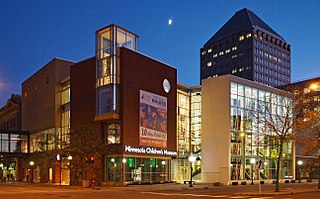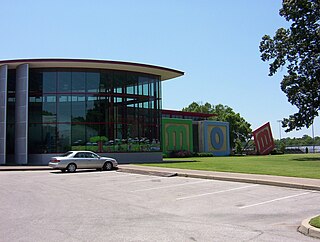
Kirkwood is an inner-ring western suburb of St. Louis located in St. Louis County, Missouri. As of the 2010 census, the city's population was 27,540. Founded in 1853, the city is named after James P. Kirkwood, builder of the Pacific Railroad through that city. It was the first planned suburb located west of the Mississippi River.

Rock Hill is a suburban town in St. Louis County, Missouri, United States. The population was 4,635 at the 2010 census. It is home to the Fairfax House on the National Register of Historic Places.
The Oregon Museum of Science and Industry is a science and technology museum in Portland, Oregon, United States. It contains three auditoriums, including a large-screen theatre, planetarium, and exhibition halls with a variety of hands-on permanent exhibits focused on natural sciences, industry, and technology. Transient exhibits span a wider range of disciplines.

Forest Park is a public park in western St. Louis, Missouri. It is a prominent civic center and covers 1,326 acres (5.37 km2). Opened in 1876, more than a decade after its proposal, the park has hosted several significant events, including the Louisiana Purchase Exposition of 1904 and the 1904 Summer Olympics. Bounded by Washington University in St. Louis, Skinker Boulevard, Lindell Boulevard, Kingshighway Boulevard, and Oakland Avenue, it is known as the "Heart of St. Louis" and features a variety of attractions, including the St. Louis Zoo, the St. Louis Art Museum, the Missouri History Museum, and the St. Louis Science Center.

The Saint Louis Science Center, founded as a planetarium in 1963, is a collection of buildings including a science museum and planetarium in St. Louis, Missouri, on the southeastern corner of Forest Park. With over 750 exhibits in a complex of over 300,000 square feet (28,000 m2), it is among the largest of its type in the United States.

The Holocaust Museum Houston is located in Houston's Museum District, in Texas. It is the fourth largest holocaust museum in the U.S. It was opened in 1996.

The Honolulu Museum of Art is an art museum in Honolulu, Hawaiʻi. The museum is the largest of its kind in the state, and was founded in 1922 by Anna Rice Cooke. The museum has one of the largest single collections of Asian and Pan-Pacific art in the United States, and since its official opening on April 8, 1927, its collections have grown to more than 55,000 works of art.

Telus World of Science Edmonton (TWOSE) is a broad-based science centre in Edmonton, Alberta, Canada, operated by the (non-profit) Edmonton Space & Science Foundation. The centre is located on the southwest corner of Coronation Park in the neighborhood of Woodcroft. The science centre houses 144,430 sq. ft. of public space and is the largest science centre in Western Canada. It is currently a member of both the Association of Science-Technology Centers (ASTC) and the Canadian Association of Science Centres (CASC).

The Houston Museum of Natural Science is a natural history museum located on the northern border of Hermann Park in Houston, Texas, United States. The museum was established in 1909 by the Houston Museum and Scientific Society, an organization whose goals were to provide a free institution for the people of Houston focusing on education and science. Museum attendance totals over two million visitors each year. The museum complex consists of a central facility with four floors of natural science halls and exhibits, the Burke Baker Planetarium, the Cockrell Butterfly Center, and the Wortham Giant Screen Theatre. The museum is one of the most popular in the United States and ranks just below New York City's American Museum of Natural History and Metropolitan Museum of Art and the M. H. de Young Memorial Museum in San Francisco in most attendance amongst non-Smithsonian museums. Much of the museum's popularity is attributed to its large number of special or guest exhibits.
The culture of St. Louis, Missouri includes a variety of attractions located within the city of St. Louis, Missouri, and in surrounding communities in Greater St. Louis, such as local museums, attractions, music, performing arts venues, and places of worship.

Techniquest is a science discovery centre located in Cardiff Bay. It gives visitors a hands-on approach to science and includes a science theatre, a planetarium, and an exhibition space with over 100 interactive exhibits aimed at visitors of all ages.

The Children's Museum of Pittsburgh is a hands-on interactive children's museum in Pittsburgh, Pennsylvania. It is in the Allegheny Center neighborhood in Pittsburgh's Northside.

Kidspace Children's Museum is a children's museum in Pasadena, California. It is located next to the Rose Bowl, in the former Fannie E. Morrison Horticultural Center.

The Minnesota Children's Museum is a children's museum in Saint Paul, Minnesota. Founded in 1981 in Minneapolis, the museum moved to St. Paul in 1995.

The Children's Museum of Memphis (CMOM) is located in Midtown Memphis at 2525 Central Avenue in Memphis, Tennessee, USA.

The Buell Children's Museum is a children's museum in Pueblo, Colorado, United States that offers hands-on exhibits focusing on the arts, science and history.

The Imagine Children's Museum is a non-profit children's museum located in Everett, Washington, near Seattle.






















